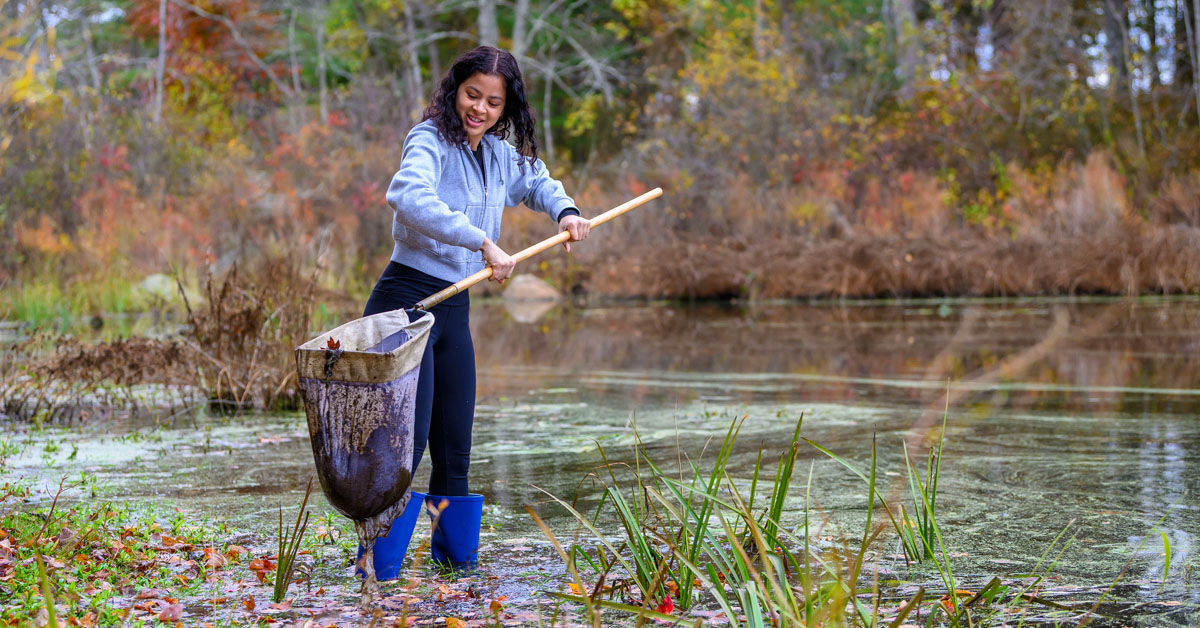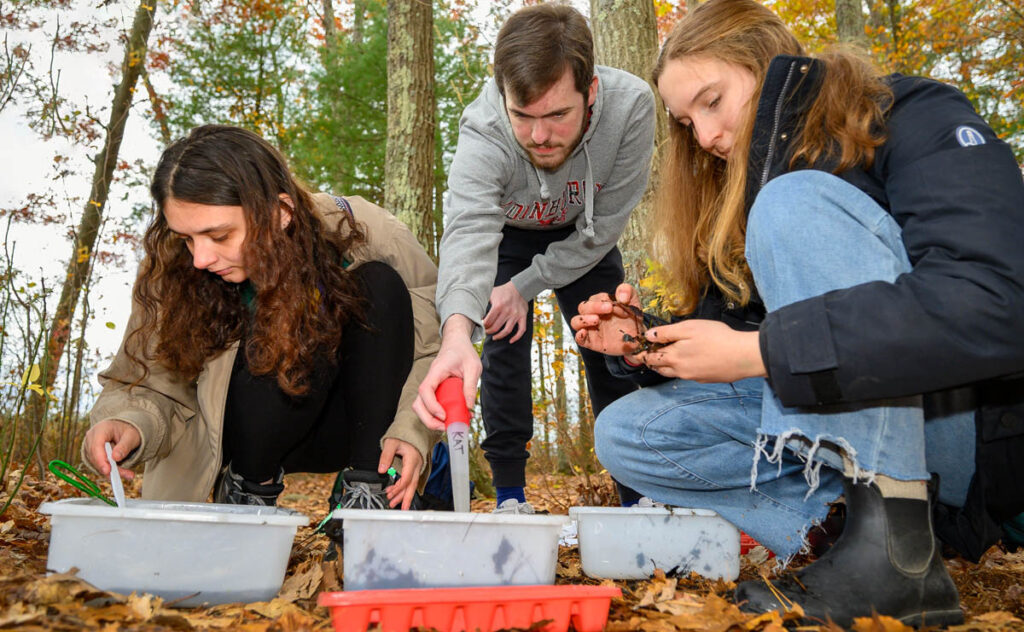Think like an ecologist

Course puts students in the field and lab to explore ecology
Students gather around Professor Kira Treibergs at the Stony Brook Wildlife Sanctuary in Norfolk, Mass. They receive a quick tutorial and gather the tools for today’s lesson—binoculars, four-foot pole nets and trays for carrying and inspecting specimens.
Then, they set off toward the woods and wetlands of the Mass Audubon preserve, which is located 20 minutes from campus.
One group gathers material from the three ponds on the property. Another group surveys bird life in the preserve—peering through binoculars, taking photos and identifying the animals with the help of an iPhone app. The groups switched halfway through the visit so each student participated in both experiences.
“Ponds are really sensitive ecosystems and can be affected by what is happening to the land around them, which we discuss and consider,” said Treibergs, professor of the practice of biology.
In a follow-up lab, an analysis of the data they collected suggests that the pollution levels are fairly low in all three aquatic ecosystems, so each one is relatively healthy.
The fieldwork and follow-up analysis speak to Treibergs’s goal for the BIO 215 course: for each student to think like an ecologist—asking good questions, gathering evidence, and applying ecological principles to address environmental challenges.
That emphasis on “doing science” reflects Treibergs’s experience as a postdoctoral associate at Cornell University, where she worked to transform lecture-based courses to learning from field and lab work.
“Through research and my personal experiences in teaching, I’ve become convinced that engaging students in the classroom and making learning a process that they participate in is the best way for them to learn,” she said.

“I want them to leave a class with an experience that will stick with them and help them in the future.”
The centerpiece of the course is a semester-long group research project that the students design with her guidance.
“I support students and help them create a project that is feasible, that we can complete in a semester, that can work in New England,” she explained. “I tell them that it’s the process, not the product, that we’re looking for. It’s really about trying something new.”
Rafael Ojeda Rexach ’26, a native of Puerto Rico, believes that the course “does a great job at balancing classroom learning with field learning. We get the best of both worlds.”
He has especially enjoyed his group research project, which involved installing trail cameras throughout Wheaton Woods (an area on campus where students conduct experiments and enjoy nature).
“We retrieve the footage weekly and we’ve seen dozens of species (deer, turkeys, coyotes and racoons),” said Ojeda Rexach. (Treibergs notes that Wheaton Woods offers a valuable resource for ecological studies without leaving campus.)
Jayden Carias ’26, an environmental science major from Newton, Mass., shared “Carrying out our group research projects has been a great opportunity to work independently while still having support from Professor Treibergs. This project has given me valuable insight into what it takes to be a field researcher and the kind of experience needed for future internships and jobs.”
The group’s first off-campus excursion was a visit to Gooseberry Island off the coast of Westport, Mass., where they explored the intertidal environment of Buzzards Bay.

“We could learn about marine invertebrates in the classroom, but flipping over rocks, looking for small creatures and taking notes on them can give us intel you would not learn in class,” said Ojeda Rexach.
Students have appreciated the real-world experiences of the biology course.
“Although I am an international relations major on a pre-law track, my main interest is environmental conservation policy, so taking an ecology class has been extremely useful in understanding the STEM side of the conservation field,” said Ojeda Rexach. “The class has me mix my knowledge in environmental policymaking with actual scientific experiments and evidence,”
In addition to field research, students explore other facets of ecological research, such as its connections to public policies and community concerns. Students in the class participate in a simulated hearing to debate whether a parasitoid wasp should be introduced in Massachusetts to try to control the population of the spotted lanternfly, an invasive species that is negatively affecting forest, residential, agricultural and urban ecosystems of the eastern U.S.
Environmental and government officials are currently debating this controversial human intervention, providing students with an active, real-world case to contemplate. The exercise enables them to research and discuss policymaking challenges while viewing ecological issues from multiple stakeholder perspectives.
Their experiences this semester have convinced some students that this may be an area they will continue to explore.
“This course has strengthened my desire to pursue field research, whether it be through a post-graduate program or a research opportunity,” said Aslan Gustafson ’27, an environmental science major from Greensboro, N.C.
Carias agreed, “This course has shown me how much I enjoy fieldwork and hands-on research. It’s confirmed that I want to continue pursuing opportunities that involve working outdoors and collecting data firsthand.”
